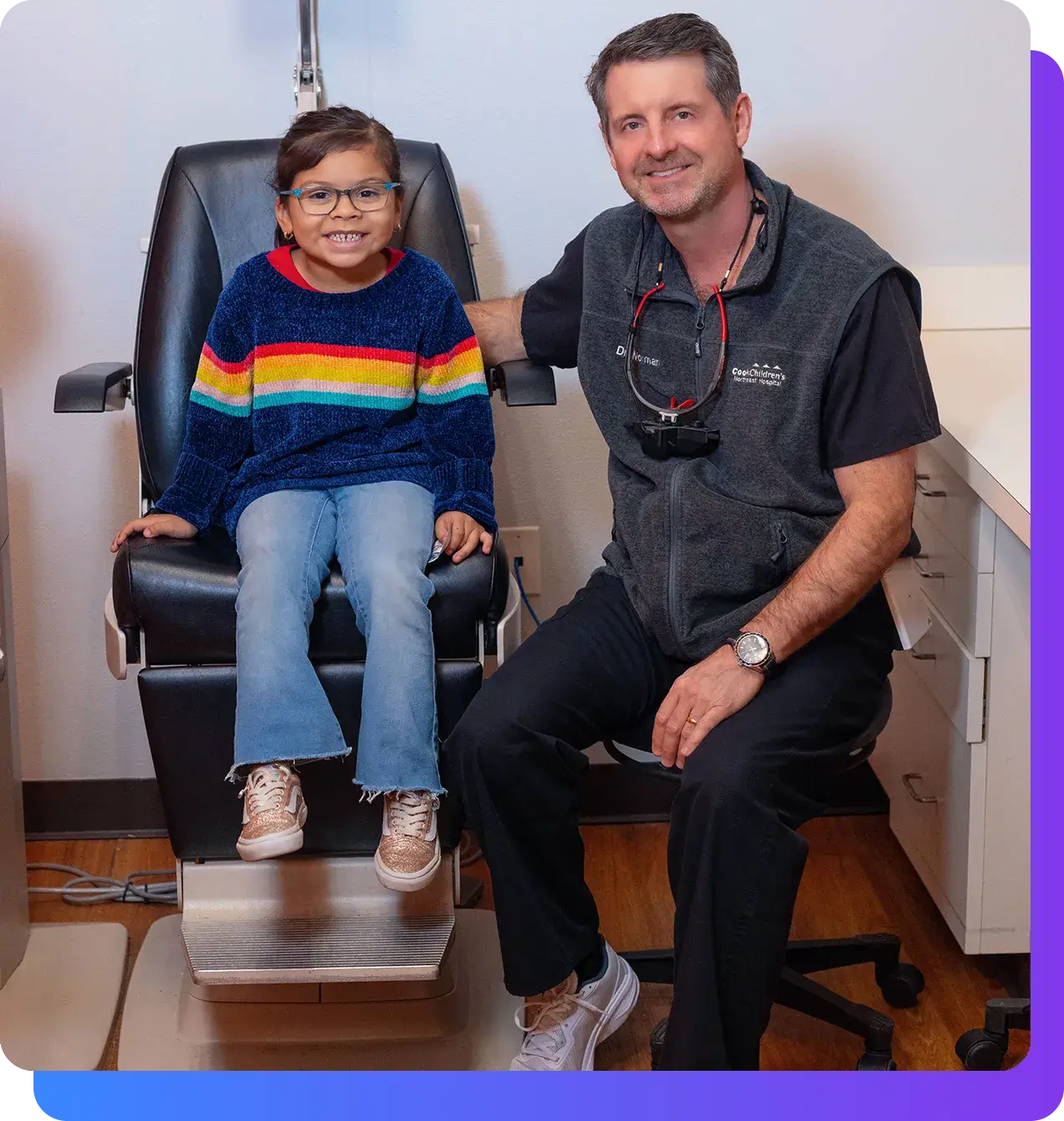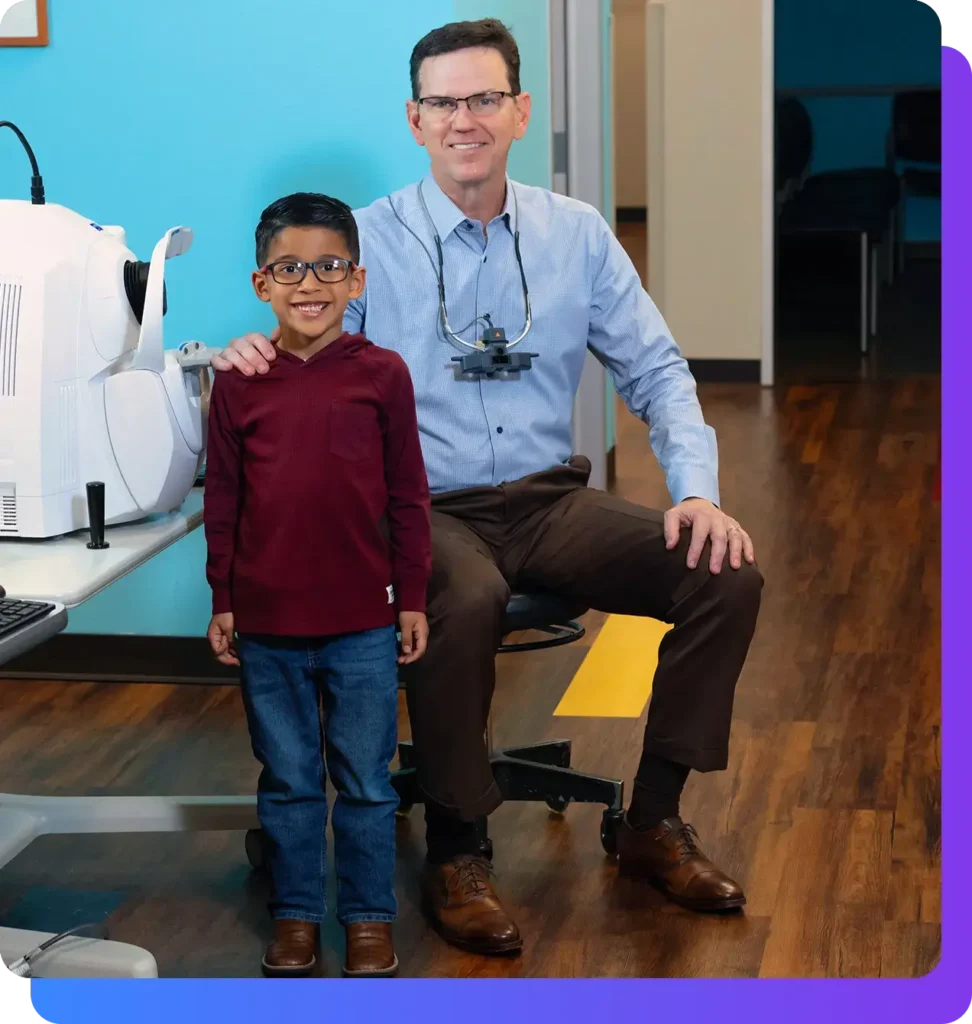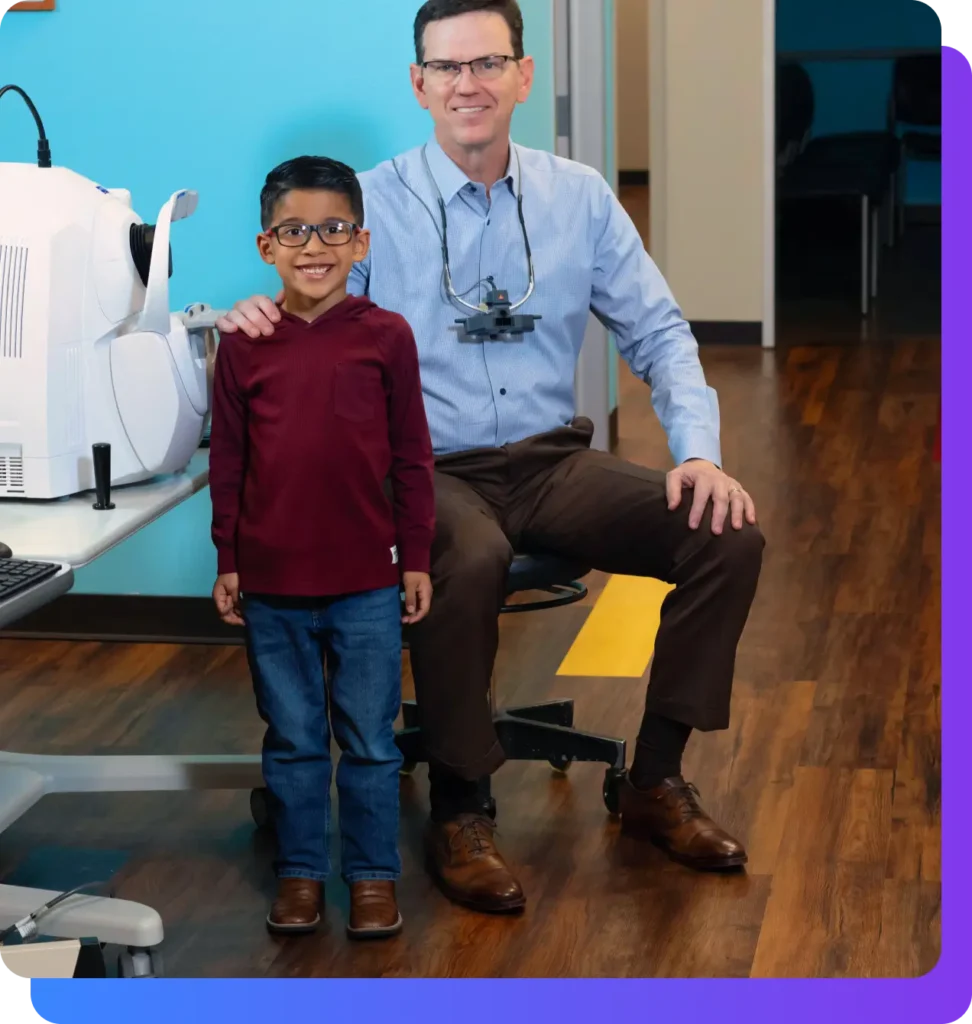Pediatric Lacrimal System Disorders
Specialists in North Texas
As a parent, you might worry about how persistent tearing or infections could affect your child’s vision and overall well-being, highlighting the importance of addressing any lacrimal system disorders promptly.
Expert Lacrimal Disorder Treatment in North Texas
Understanding your child’s lacrimal system is essential, as it plays a crucial role in their ocular health and comfort. Despite its small size, the lacrimal system’s function impacts your child’s daily activities by maintaining eye moisture and comfort. Tear duct disorders are among the most common pediatric conditions we treat at Pediatric Eye Specialists. With our compassionate approach and specialized care, these challenges are not only manageable, but often fully resolvable. Trust that you are not alone on this journey. Our specialized, kid-friendly care ensures that these issues are manageable and often fully resolvable. You’re not alone; we’re here to guide you toward clear eyes and happy smiles for your child.

The Basics: What are Lacrimal System Disorders?
Lacrimal system disorders in children encompass a range of conditions that affect the eyes’ ability to produce and drain tears properly. These disorders can lead to symptoms such as excessive tearing, ocular discomfort, crusting or mattering of the eyelashes, eyelid skin discomfort, or more rarely, recurrent eye infections. While these could arise from congenital anomalies, blockages, or infections of the tear ducts, more commonly this is something that a large percentage of young infants experience. Properly functioning lacrimal systems are vital for the lubrication and protection of the eyes, and when disorders are present, they can impact a child’s quality of life by causing discomfort or impairing vision. Timely diagnosis and treatment of these disorders are important to manage symptoms.
Why Pediatric Eye Specialists for Lacrimal System Disorders
The Most Experienced Team in North Texas
With over sixty-five years of collective pediatric ophthalmology expertise, we offer your child unparalleled collaborative care.
Five Convenient Locations
Easily accessible care with offices in Fort Worth, Denton, Southlake, Mansfield, and Prosper,
Unrushed, Clear Communication
We take the time to discuss your child's diagnosis and treatment, ensuring all your questions are answered to ease your concerns.
Affiliated with Cook Children’s Hospital
Our partnership with Cook Children’s Hospital means if your child needs surgery, imaging, or other specialists, they will be treated in one of the nation’s leading pediatric hospitals.
Specialized Expertise
Our expertise means that more optometrists, doctors, and specialists refer their pediatric eye patients to Pediatric Eye Specialists than any other pediatric eye practice in North Texas.
Child and Family Focused
Kids love us, and we love kids! We provide a caring environment for your child and your family.
Advanced Diagnostic Technology
We have the most comprehensive pediatric diagnostic suite in North Texas, allowing for precise diagnosis and highly personalized treatment plans.
Every Child Needs Access to Expert Eye Care
Championing the right to sight, we help navigate insurance, cash pay, and Medicaid options to make superior eye care feasible for all children regardless of their socioeconomic status.

Benefits of Addressing Lacrimal System Disorders Early
Addressing lacrimal system disorders early in children can significantly improve their quality of life and prevent long-term complications.
Success You Can Expect for Your Child
Prevention of Infection
While most congenital nasolacrimal duct obstructions do not lead to infections, certain infants may be at higher risk of secondary complications. Infants, such as those with a dacryocele, need early identification and treatment.
Enhanced Comfort
Addressing lacrimal system disorders promptly can significantly alleviate symptoms like epiphora (excessive tearing) and discharge. These conditions, often caused by nasolacrimal duct obstruction or other tear drainage system issues, can lead to discomfort. Timely treatment restores comfort, allowing your child to enjoy their daily activities without the irritation of constant tears or discharge.
Better Vision
Clear tear drainage is essential for maintaining healthy eyes and supporting optimal visual development and acuity in children. Intervention in conditions like congenital nasolacrimal duct obstruction ensures that tear film health is maintained, which is essential for clear vision. Ensuring that tears drain properly helps prevent complications like chronic eye irritation or photophobia, which can affect a child's vision and learning experience.
Reduced Complications
Timely and appropriate treatment of lacrimal system disorders helps in avoiding further complications. For instance, unresolved nasolacrimal duct obstruction can lead to persistent tearing, recurrent eye infections, or even more severe conditions like cellulitis. Timely intervention, possibly including nasolacrimal duct probing or balloon catheter dilation, can reduce these risks significantly.
Emotional Well-Being
The impact of unresolved tear duct issues extends beyond physical discomfort; it can also affect a child's emotional well-being. Children who experience chronic eye problems may become frustrated or self-conscious, particularly in social or educational settings. Resolving these issues not only improves their physical health, but also boosts their confidence and emotional resilience.
Real Stories,
Real Smiles.
“They were very good with my nonverbal toddler. It was the best doctor visit experience we have had yet. They were awesome, caring, and quick!.”

Amy Glover
Parent of Patient
“Today, Dr. Packwood saved my youngest from a life of blindness and worked a miracle for my family. I cannot express enough gratitude and thanks for their skillful surgery and expertise. 10 of 10 highly recommend.”

Atticus Lee
Parent of Patient
“The staff here is so amazing with my son. We had such a wonderful experience both at the office and for his surgery! I highly recommend Pediatric Eye Specialists!!!!“

Gianna Stutzman
Parent of Patient
“We are so grateful for the genuine care that Dr. Duff provided for our son Lorenzo, which prevented him from going blind! She is truly a gift to the community.“

JS Cocjin
Parent of Patient
“Professional, compassionate, kind and friendly. They took great care of my preemie baby from Day 1 of ROP. Very happy with how my daughter is progressing and has healthy eyes now.”

Suresh K.C.
Parent of Patient
“We’ve seen Dr. Hunt for the past 6 years since my daughter was 9 days old. We have multiple appointments each year and even eye surgery when she was 1. Our experience here has been fantastic every time and we highly recommend this group!.”

Mandy Edmondson
Parent of Patient
“Dr. Norman has always been very attentive and thorough with my daughter, who has Type 1 Diabetes. The staff are warm and always do their best to be accommodating. I highly recommend Dr. Norman.”

Tricia Moon
Parent of Patient
“Absolutely recommend! All around great experience! They made my son feel comfortable during the visit. Treatment was explained, and I walked out with no questions. I loved it. “

Cynthia Valero
Parent of Patient
“Great staff, great doctors; they know how to help ease kids’ fears and provide excellent service. Had to get my little one in same day for an eye injury, and they found a way to make it happen. Would 100% recommend.“

Kris K
Parent of Patient
Start your child’s journey to better vision today.
Embrace a future of clearer vision and confidence for your child. Contact us now to book your consultation at any of our convenient locations across the Metroplex.
Click to Explore Tear Duct Disorders
Causes of Lacrimal System Disorders
Lacrimal system disorders in children, particularly conditions like nasolacrimal duct obstruction (NLDO), can arise from various sources. Understanding these causes is key to effective treatment and management.
Congenital Factors
Many tear duct disorders are congenital, meaning they are present from birth. Conditions such as congenital nasolacrimal duct obstruction occur due to the incomplete development of the nasolacrimal system. In some cases, the duct may not be fully open or can be blocked by a thin membrane at the distal end, known as the valve of Hasner. May congenital nasolacrimal duct obstructions will resolve as the child grows. We will discuss with you and your family when is an appropriate time to consider waiting for further growth and when a treatment should be considered.
Infections
Some infants and children, such as those with a dacryocystocele (also known as a dacryocele or mucocele), may be susceptible to infections that can affect the lacrimal system. A dacryocystocele presents as a bluish swelling just below the eye and next to the nose. An infant may be born with a dacryocystocele, which is essentially where fluid is being produced in the nasolacrimal system, but can not escape through the top or bottom of the system. Infections of a dacryocystocele can be extremely dangerous and must be treated promptly. Other forms of infections of the nasolacrimal sac such as dacryocystitis (an infection of the lacrimal sac), which common in adults, are more rare in children.
Anatomical Variations
Anomalies in the anatomy of the lacrimal apparatus, such as narrow ducts or abnormal development of lacrimal puncta, canaliculi, or the lacrimal sac, can impede tear flow. These variations can lead to tear retention and subsequent problems.
Understanding these causes is vital for Pediatric Eye Specialists in diagnosing and formulating an effective treatment plan for lacrimal system disorders.
Signs and Symptoms of Lacrimal System Disorders
Recognizing the signs and symptoms of lacrimal system disorders early can lead to timely and effective treatment. Here are some common indicators:
Persistent Tearing (Epiphora)
One of the most noticeable signs is the continuous overflow of tears, often observed in congenital nasolacrimal duct obstruction. This can be more apparent in windy or cold weather, as tears are produced to protect the eye but do not drain properly. Rarely, this could also be a symptom of congenital glaucoma.
Discharge
Accumulation of mucus in the corner of the eye or along the eyelid is a common symptom, typically indicative of tear duct blockage. While this could be a sign of infection, true infections are more rare than a congenital nasolacrimal duct obstruction.
Swelling
In cases like a dacryocystocele (a cystic expansion of the lacrimal sac), there can be noticeable swelling near the inner corner of the eye. This is urgent, if not emergent, and requires treatment.
Redness
Redness or inflammation around the eye or along the nasal side of the lower eyelid can occur. Frequently this is from irritation from the constant tearing or mucus, rather than a true infection. We will assess if this is a true infection or just ocular irritation.
Skin Irritation
Chronic wetness from tearing can lead to skin irritation or infection on the skin adjacent to the eye. This can be uncomfortable for infants and may lead us to offer treatment earlier than we may otherwise have considered.
Have Concerns?
By understanding the various causes and being vigilant about the signs and symptoms of lacrimal system disorders and blocked tear ducts, parents can take proactive steps in seeking medical advice from pediatric ophthalmology experts like those at Pediatric Eye Specialists. Timely detection and intervention are crucial for the effective management of these disorders and ensuring the overall ocular health of the child. We would prefer to see your baby prior to 1 year of age (although around 9 months may be more beneficial), if at all possible, so that we can offer you the full spectrum of treatment options that may not be available as your child grows larger.
Diagnosing Lacrimal System Disorders
Diagnosing lacrimal system disorders in children involves a comprehensive approach that combines clinical examination, occasionally diagnostic imaging, and sometimes referral to other specialists. Pediatric Eye Specialists utilizes a meticulous process to ensure accurate diagnoses and effective treatment plans.
Clinical Examination
- Assessment of Symptoms: The ophthalmologist will evaluate common symptoms such as persistent tearing (epiphora), discharge, and any noticeable swelling or redness around the eyes.
- Assessment of Intraocular Pressure: The ophthalmologist will evaluate other things, such as the intraocular pressure of the eyes, to ensure a masquerading condition is not present.
- Examination of the Lacrimal Apparatus: This involves inspecting the eyelids, lacrimal punctum, lacrimal sac, and nasolacrimal duct. The physician might gently press on the lacrimal sac to observe if any fluid (mucus or pus) is regurgitated through the puncta, indicating a blockage.
- Observation of Tear Flow: The doctor may watch how tears drain or assess how much fluid is sitting on the eye.
Diagnostic Imaging
- Computed Tomography (CT) and Magnetic Resonance Imaging (MRI): These imaging modalities provide detailed views of the lacrimal system’s anatomy and are particularly useful in identifying anatomical abnormalities or other underlying conditions.
- Ultrasound: In some cases, ultrasound imaging may be used to evaluate the lacrimal sac and duct.
Collaboration with Other Specialists
- ENT Specialists: If there is suspicion of an issue extending into the nasal cavity or sinus area, such as in cases of complex congenital nasolacrimal duct obstruction, a consultation with an ear, nose, and throat (ENT) specialist may be recommended.
- Pediatric Radiologists: These specialists may be called to interpret advanced imaging results, especially in complex or unusual cases.
- Geneticists or Other Specialists: In rare cases, other specialists may be called if there is an indication of a systemic or genetic condition affecting the lacrimal system.
Treatments for Lacrimal System Disorders
At Pediatric Eye Specialists, we offer a spectrum of treatments for lacrimal system disorders, tailored to the specific needs and conditions of each child. Our approach ranges from conservative management to more advanced surgical interventions, always prioritizing the safety and comfort of our young patients.
Conservative Management
- Massage: A gentle massage over the lacrimal sac area can sometimes help open up a partially blocked nasolacrimal duct. This technique is occasionally effective in infants and can be easily performed by parents after proper instruction.
- Antibiotics: If there’s an infection present, such as in cases of dacryocystitis, antibiotic eye drops or ointments are prescribed to combat the infection and reduce inflammation. For typical congenital nasolacrimal duct obstructions, antibiotics are not an effective way to treat the condition.
- Warm Compresses and Eyelid Scrubs: Applying warm compresses and using baby shampoo to clean the eyelashes can provide relief from discomfort. Despite the appearance of the eyelashes, many child are not strongly symptomatic if the crusting and mucus can be cleaned from the lashes.
- Time: Most children just need time to grow. If your child is less than 6 months, statistically speaking your child should grow out of a congenital nasolacrimal duct obstruction. After your child is around 9 months of age, if the condition is still present, the changes of growth resolving the issue decrease dramatically.
Surgical Interventions
When conservative treatments do not yield the desired results or in cases of more significant blockages or symptoms, surgical options are considered:
- Probing: Nasolacrimal duct probing is a common procedure for treating tear duct blockages, especially in infants and toddlers. It involves gently passing a thin probe through the nasolacrimal duct to clear the obstruction. In small children, this can frequently be performed in clinic. Once we feel that an infant is too large or if we are concerned in any way that an infant may remember the quick procedure, we suggest doing the procedure in the operating room under general anesthesia.
- Balloon Catheter Dilation: For cases of diffuse stenosis or blockages resistant to simple probing, balloon catheter dilation is an effective alternative. It involves the insertion of a tiny balloon which is then inflated to widen the duct and facilitate proper drainage. While this can not be done in the clinic, some physicians may offer this procedure if the child is too old to have a simple probing in clinic.
- Stent Placement: In certain cases, a stent may be placed to keep the tear duct open. This is almost never the first procedure that is performed, but may be considered if a previous method has failed. This is often a temporary measure, allowing natural healing and patency of the duct. The stent is removed safely in clinic several weeks to months after it is placed.
Understanding Anesthesia in Pediatric Eye Procedures
Anesthesia plays a critical role in ensuring the safety and comfort of children undergoing eye procedures. In pediatric ophthalmology, particularly for treatments involving the lacrimal apparatus like probing in older children or balloon catheter dilation, general anesthesia is commonly used. This ensures that the child remains still and comfortable throughout the procedure. The types of anesthesia used are carefully selected and administered by experienced anesthesiologists, with a focus on maintaining the utmost safety. Parents can be reassured that every measure is taken to monitor the child’s vital signs and overall health throughout the procedure, ensuring a safe and anxiety-free experience for both the child and the parents.
The Role of Pediatric Eye Drops in Treatment
Eye drops play a versatile role in the treatment of pediatric lacrimal system disorders. Depending on the condition, different types of eye drops, such as antibiotic eye drops, may be utilized to treat conjunctivitis. However, it is important to note that topical antibiotics are not a cure for congenital nasolacrimal duct obstructions. For conditions causing dryness or irritation, lubricating eye drops can provide much-needed relief. These medications are an integral part of treatment, aiding in both immediate symptom relief and long-term recovery, and are carefully chosen based on the specific needs of each child.
Addressing Tear Duct Issues in Infants
In infants, tear duct disorders like nasolacrimal duct obstructions are common. Parents might notice symptoms such as excessive tearing or discharge from the eyes. Special treatment protocols are in place for infants, starting with conservative approaches like tear duct massage. If these initial measures do not resolve the issue, procedures such as nasolacrimal duct probing are considered. Due to the delicate nature of an infant’s developing lacrimal system, these treatments are performed with extra care and precision.
In every treatment plan, our primary goal is to restore proper tear drainage, alleviate symptoms, and improve the overall quality of life for our young patients. The team at Pediatric Eye Specialists is dedicated to providing comprehensive care, from initial consultation to follow-up after treatment, ensuring your child receives the best possible outcome for their lacrimal system disorder.
Our commitment at Pediatric Eye Specialists is to provide your child with the highest standard of care, combining medical expertise with compassion and understanding.
Typical Expected Outcomes for Tear Duct and Tear Sac Disorders
At Pediatric Eye Specialists, our experience and expertise in treating lacrimal system disorders allow us to offer families a positive outlook for their children’s eye health. Understanding the typical expected outcomes following treatment for tear duct obstructions and other lacrimal disorders can provide reassurance and hope to concerned parents.
High Success Rates in Tear Duct Obstruction Treatments
- Probing Success: Probing for nasolacrimal duct obstruction, particularly in infants and toddlers, boasts high success rates. Most children experience immediate relief from symptoms like excessive tearing and discharge. The procedure’s simplicity and effectiveness make it a first-line treatment.
- Long-Term Relief: Following successful probing or other interventions, the majority of children will have long-term relief from symptoms. Recurrences are relatively rare, and if they occur, are typically manageable with further treatment.
Positive Outcomes in Other Lacrimal Disorders
- Resolution of Infections: Treatments for conditions like dacryocystitis, which involve infection of a dacryocele, are usually very effective. With appropriate antibiotic therapy and surgical intervention, children typically recover without any long-term adverse effects on their eye health.
- Improved Quality of Life: Beyond the physical relief, resolving lacrimal system disorders significantly enhances a child’s quality of life. Children typically return to their normal activities with improved comfort and without the constant bother of eye irritation, tearing, or infections.
- Minimally Invasive Techniques: The use of minimally invasive techniques has led to improved outcomes in terms of recovery time and overall effectiveness, particularly in more complex cases.
Ongoing Care and Monitoring
- Follow-Up Care: Regular follow-up appointments after treatment ensure that the lacrimal system continues to function correctly and helps in the early identification and management of any potential recurrence.
At Pediatric Eye Specialists, we are committed to providing personalized, comprehensive care to ensure the best possible outcomes for our young patients with lacrimal system disorders. Our approach employs the latest techniques and provides thorough follow-up care to maintain the health and well-being of your child’s eyes. Our goal is to suggest the best care for your family. Some families need earlier treatments, especially if the condition is causing raw-appearing skin around an infant’s eye or disruption childcare options for your family. Other families prefer later treatments with the hopes that their child may still improve on his or her own. We aim to provide the least invasive options, while educating families so that they can choose the best options for their babies individually.
Secure a Brighter Future: Schedule Your Child's Lacrimal System Disorders Consultation Today
At Pediatric Eye Specialists, we understand the importance of your child’s eye health and the trust you place in us for their care. If your child is experiencing symptoms of lacrimal system disorders, don’t wait for them to worsen. Take the first step towards clear and comfortable vision for your child. Contact us today to schedule an appointment. Our team of compassionate experts is here to provide the best care, from diagnosis to treatment and beyond. Let us guide you and your child back to a world of bright and healthy vision.

Start your child’s journey to better vision today.
Embrace a future of clearer vision and confidence for your child. Contact us now to book your consultation at any of our convenient locations across the Metroplex.
What role does the lacrimal gland play in tear production, and how does it relate to blocked tear ducts in children?
The lacrimal gland is essential in tear production, providing necessary lubrication to maintain eye health. The lacrimal gland is rarely a problem in young children. Rather, the drainage of these tears from the eye, called the nasolacrimal duct system, is frequently too small or blocked. In children, a blocked nasolacrimal duct, can prevent these tears from draining normally, leading to a condition called epiphora, where tears overflow onto the cheeks. This is often due to a developmental issue where the tear duct system, including the lacrimal bone and canaliculi, hasn’t fully opened or has been obstructed, resulting in tear duct issues.
What is the purpose of irrigation in the treatment of blocked tear ducts?
Irrigation is a procedure where a saline solution is flushed through the lacrimal system to clear any blockages within the lacrimal canaliculi or duct. It is typically performed at the same time as the probing. It’s a common and minimally invasive treatment that can sometimes be performed in the clinic and can often provide immediate relief from symptoms.
My child constantly has watery eyes. Could this be a sign of a blocked tear duct, and if so, what treatment options are available?
Yes, watery eyes or epiphora is a classic symptom of a blocked tear duct. Treatment may range from simple conservative measures like massage to surgical interventions. Surgical interventions typically include probings and irrigation, balloon dilation of the nasolacrimal duct system, or a stent placement. Very rarely, none of these treatments may be effect and a surgery called a dacryocystorhinostomy (DCR) (where a new pathway for tear drainage is created, bypassing the blocked portion of the tear duct) may be performed.
How do you diagnose a blocked tear duct in an infant, and are there risks associated with the condition?
The diagnosis usually starts with a clinical examination, observing symptoms like excessive tearing or discharge. Most children will grow out of the condition, but in those that do not or are extremely symptomatic, treatments are available.
Are there any nonsurgical treatments for children with blocked tear ducts?
Yes, before considering surgery, nonsurgical options such as regular tear duct massage are used to manage the symptoms and try to open the blocked duct. In many infants, the tear duct opens on its own by the time they reach six to nine months of age.
Can a nasolacrimal duct cyst be a birth defect, and how is it usually detected in infants?
Yes, a nasolacrimal duct cyst can be a congenital birth defect, occurring when the nasolacrimal duct (NLD), which drains tears from the eye to the nose, is blocked. It is typically detected shortly after birth when parents notice tearfulness and swelling near the inner corners of their infant’s eyes, where the tear duct opens into the nose.
My child has been diagnosed with NLD obstruction. Can you explain what NLD stands for and what this means for my child?
NLD stands for nasolacrimal duct, which is a passage that allows tears to drain from the eye into the nose. An obstruction in this duct can lead to tears accumulating and spilling over the eyelids (a condition known as epiphora). Treatment is often necessary to restore proper tear drainage and prevent complications.
How does the anatomy of the human eye connect to the human nose in the context of tear drainage?
The human eye has a lacrimal system that produces and drains tears. Once tears lubricate the eye, they drain through tiny openings called puncta, into the lacrimal canaliculi, then into the lacrimal sac, and eventually through the nasolacrimal duct, which opens into the human nose. This system is essential for tear drainage and any blockage can lead to tear duct disorders.
Are there any specific concerns regarding the treatment of tear duct issues related to skeletal muscle?
While skeletal muscle does not directly affect the lacrimal drainage system, issues with the facial skeletal muscles can impact tear drainage indirectly. For example, if there’s a muscular issue that affects eyelid function, it can interfere with the normal blinking mechanism, essential for pumping tears through the lacrimal system.
What can we expect from the practice of medicine when it comes to advances in treating lacrimal system disorders?
The practice of medicine, especially in ophthalmology, is continuously evolving with advances in technology and treatment protocols. You can expect ongoing improvements in diagnostic accuracy with imaging techniques and in treatment effectiveness, including less invasive procedures and more precise interventions that cater to the specific needs of pediatric patients with lacrimal system disorders.